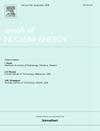Reactivity measurement using pulsed neutron source methods on VR-1 and VR-2 reactors and their verification by SERPENT code
IF 1.9
3区 工程技术
Q1 NUCLEAR SCIENCE & TECHNOLOGY
引用次数: 0
Abstract
A series of pulse experiments were carried out on the VR-1 reactor and the newly constructed subcritical VR-2 assembly at the Czech Technical University (CTU) in Prague. The objective was to compare the results obtained from the pulse methods with the verified Monte Carlo (Serpent) model for VR-1 reactor and to investigate the potential for the process of experimental verification of the Monte Carlo model for the new VR-2 reactor. The Simmons-King’s, Sjöstrand’s, Gozani’s, and Garelis–Russell’s methods were applied to data collected from detectors located at different positions in a pulse experiment. Additionally, the Monte Carlo method was employed for the determination of the kinetic parameters essential for the comparison and application of the pulse methods. A very simple Serpent simulation of the Sjöstrand’s method was introduced. Although the used pulse source in some of its parameters (frequency, duty factor) indicated a certain limit of applicability, the expected, relatively good agreement between the experiment and the Monte Carlo model was achieved in the investigated range of reactivities for the VR-1 reactor. Therefore, it can be concluded that pulse methods in this range provide a reasonably reliable means of determining reactivity. The discrepancies observed at the VR-2 subcritical assembly indicate the necessity for a rigorous review of its existing Monte Carlo model.
用脉冲中子源方法测量VR-1和VR-2反应堆的反应性,并用SERPENT代码验证
在布拉格捷克技术大学(CTU)的VR-1反应堆和新建的次临界VR-2组件上进行了一系列脉冲实验。目的是将脉冲方法获得的结果与VR-1反应堆已验证的蒙特卡罗(Serpent)模型进行比较,并研究新的VR-2反应堆的蒙特卡罗模型的实验验证过程的潜力。西蒙斯-金、Sjöstrand、戈扎尼和加雷利斯-罗素的方法被应用于脉冲实验中从不同位置的探测器收集的数据。此外,采用蒙特卡罗方法确定了脉冲方法比较和应用所必需的动力学参数。介绍了Sjöstrand方法的一个非常简单的Serpent模拟。虽然所使用的脉冲源在某些参数(频率、占空因子)上显示出一定的适用性限制,但在VR-1反应堆的研究反应性范围内,实验与蒙特卡罗模型之间达到了预期的、相对较好的一致性。因此,可以得出结论,脉冲法在这个范围内提供了一种相当可靠的测定反应性的方法。在VR-2亚临界装置上观察到的差异表明有必要对其现有的蒙特卡罗模型进行严格审查。
本文章由计算机程序翻译,如有差异,请以英文原文为准。
求助全文
约1分钟内获得全文
求助全文
来源期刊

Annals of Nuclear Energy
工程技术-核科学技术
CiteScore
4.30
自引率
21.10%
发文量
632
审稿时长
7.3 months
期刊介绍:
Annals of Nuclear Energy provides an international medium for the communication of original research, ideas and developments in all areas of the field of nuclear energy science and technology. Its scope embraces nuclear fuel reserves, fuel cycles and cost, materials, processing, system and component technology (fission only), design and optimization, direct conversion of nuclear energy sources, environmental control, reactor physics, heat transfer and fluid dynamics, structural analysis, fuel management, future developments, nuclear fuel and safety, nuclear aerosol, neutron physics, computer technology (both software and hardware), risk assessment, radioactive waste disposal and reactor thermal hydraulics. Papers submitted to Annals need to demonstrate a clear link to nuclear power generation/nuclear engineering. Papers which deal with pure nuclear physics, pure health physics, imaging, or attenuation and shielding properties of concretes and various geological materials are not within the scope of the journal. Also, papers that deal with policy or economics are not within the scope of the journal.
 求助内容:
求助内容: 应助结果提醒方式:
应助结果提醒方式:


